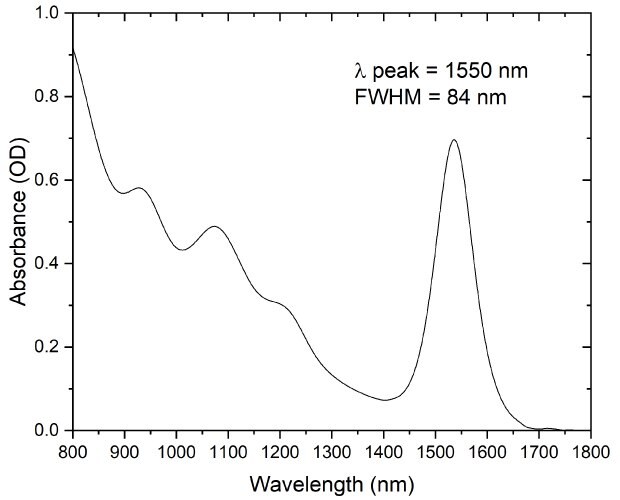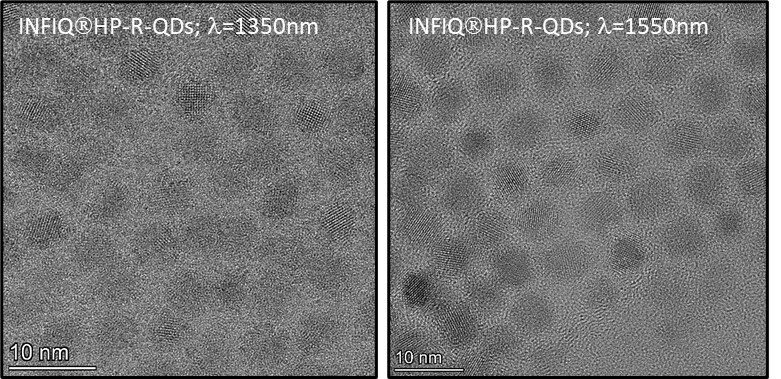Infrared Lead Sulfide Quantum Dots: Properties and Applications
Stuart Stubbs, Product Director
Quantum Science Ltd., Daresbury, UK
Introduction
Infrared lead sulfide-based quantum dots are capable of absorbing and emitting light across the near-infrared (NIR) and short-wave infrared (SWIR) wavelengths in the electromagnetic spectrum. This quantum dot technology has been intensively researched and developed for commercial application in photodetectors, photovoltaics, and infrared light emitters.
Optical and physical properties of infrared PbS quantum dots
The semiconductor band gap of the lead-sulfide (PbS) quantum dots can be controlled by the size, whereby longer wavelength absorbing materials represent larger nanoparticles. The excitonic absorption peak wavelength is an important parameter for the use of quantum dots in optoelectronic applications and is a tightly controlled specification of the quantum dot. The excitonic absorption peak wavelength can be observed as a strongly absorbing peak at slightly higher energy than the absorption onset. The width of this peak is defined by the full width at half maximum (FWHM). A narrower FWHM is indicative of a monodisperse ensemble of nanoparticles, meaning the nanoparticles are all a very similar size. This is highly desirable in applications where a flat energy landscape, a narrow energy distribution, and the formation of superlattices yield improved performance. In this regard, our infrared lead sulfide-based quantum dots, with a FWHM of less than 120 nm, offer best-in-class optical properties.

Figure 1. Absorption spectra showing the optical properties of QS quantum dots
The uniform shape and size distribution of the materials can be observed using transmission electron microscopy (TEM). TEM also demonstrates that our infrared PbS quantum dots are monodisperse. Our PbS quantum dots, absorbing at 1350 nm (925543, INFIQ® HP-R-1350 nm) and 1550 nm (925535, INFIQ® HP-R-1550 nm), have diameters approximately 4.9 ± 0.1 nm and 6.0 ± 0.1 nm, respectively. The high crystallinity of the nanomaterials can also be observed through the crystal lattice structure evident in the individual QDs. Highly crystalline nanoparticles have fewer defects and electronic trap states which are known to degrade performance in devices.

Figure 2.TEM images for different sizes of infrared PbS materials
Surface chemistry of infrared PbS quantum dots
The ligands on the surface of the QDs are long-chain organic molecules optimized for synthetic control and colloidal stability. The surface chemistry of our infrared PbS quantum dots is incredibly versatile, allowing them to be redispersed in a large array of solvents, and functionalized for coating in many device designs. Versatility is key to allowing users to tailor the materials to their specific processes.
The application of PbS-based quantum dot technology often requires a further surface modification step because the presence of long alkyl chain ligands can limit charge transport within superlattices and thin films. These PbS quantum dots can be subject to solid state ligand exchanges using cross-linking materials such as benzenedithiol and ethanedithiol, or solution-phase ligand exchanged using a wide variety or organic and inorganic ligand species.
Application of infrared PbS quantum dots
Infrared lead sulfide quantum dot technology has been intensively researched and developed for applications in photodetectors, photovoltaics, and infrared light emitters.
- Infrared photodetectors based on solution processing of PbS nanoparticles have reported photon conversion efficiencies of over 80%, giving excellent sensitivity in the short wave infrared (SWIR)[1].
- Photovoltaics using PbS quantum dots can access the infrared spectrum, which is not easily accessible using traditional solar cells. This is advantageous as half of the solar energy reaching the earth is in the infrared region. These devices can be designed as single junction solar cells or multijunction “tandem” cells [2].
- Infrared light emitting diodes (LEDs) find wide application in several areas such as surveillance and security, night vision, biomedical imaging, and spectroscopy [3].
By rigidly controlling the synthesis, the infrared PbS quantum dots achieve superior optical performance. In addition, well-controlled surface science yields robust materials resistant to elevated temperatures for prolonged periods. The materials presented here have been demonstrated to withstand temperatures up to 150°C for 30 minutes with no change in the optical properties. This serves as a leading indicator that the materials can withstand shorter periods of high temperature during post-processing in device fabrication.
Conclusions
Our high-performance infrared PbS quantum dots are suitable for a wide range of applications. Owing to intensive research and development, these quantum dots have well-characterized optical and electronic properties. Flexible surface chemistry and facile modification make them a versatile class of materials suitable for academic research and integration into optoelectronic devices.
Quantum Science Ltd is a leading British materials innovation company that focuses on developing and commercializing technologies for machine-vision and sensing markets.
References
To continue reading please sign in or create an account.
Don't Have An Account?